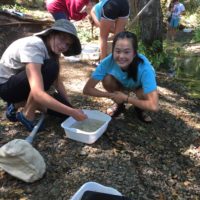Growing up in Corvallis, in the heart of Oregon’s Willamette Valley, students are surrounded by fertile farmland and rivers rich with wildlife and birds.
Head south 2,000 miles to Central Mexico, and you’ll find a similar—if more arid—river valley rich with wildlife, where children grow up amidst farmlands along the Río Laja in the state of Guanajuato.
It turns out these river valleys have even more in common: More than 40 wildlife species are shared between them, including three migratory birds: great blue heron, rufous hummingbird, and black-throated gray warbler.
With support from the Gray Family Foundation, students from these “Twinning” watersheds are making personal—and impactful—connections by focusing on these three migratory birds.
Through the Classrooms Across Borders project, dual-language (Spanish-English) third-graders in Corvallis share stories, writing, and artwork with rural students from Guanajuato, Mexico. Led by The Institute for Applied Ecology, Marys River Watershed Council and Greenbelt Land Trust, the project engages students in learning about keeping their watersheds healthy.
In addition to classroom lessons, the youth take field trips to the rolling green hills of Greenbelt Land Trust’s Bald Hill Farm in Corvallis. Out in the field, students spot birds with binoculars and run an obstacle course that simulates the challenges that migratory birds encounter.
By their sides are bilingual high-school mentors from the Corvallis area, who help lead the lessons in Spanish, thanks to a program supported by the Meyer Memorial Trust. To bolster this effort, the Gray Family Foundation supported a Peer Mentor Workshop at Bald Hill Farm over the summer that prepared the high-schoolers to become environmental educators.
“The kids just light up when they get to work alongside these high-schoolers,” says Stacy Moore, Ecological Education Program Director for the Institute for Applied Ecology.
At the end of the 2019 school year, the elementary students exchanged postcards with students in Guanajuato, including bird drawings and personal stories. Four Oregon teachers hand-delivered the postcards in June during a special exchange in which they met with fellow educators and partners in Mexico who are conserving the Rio Laja.
Classrooms Across Borders is a key piece of the Willamette-Laja Twinning Project, part of the Willamette River Initiative, which brings together students, teachers and conservationists to connect culturally around shared migratory birds and help conserve their habitats, which are disappearing across North America.
Additional key partners in this initiative include Benton Soil and Water Conservation District, Calapooia Watershed Council, the Oregon Natural Resources Conservation District (NRCS), Cascade Pacific Resource Conservation and Development, Instituto Tecnolȯgico Superior de Irapuato (ITESI), Cuerpos de Conservación Guanajuato, Salvemos al Rio Laja, and Cascade Pacific Resource Conservation & Development, and Audubon de Mexico.
An instructor at one of the sister schools in Mexico shared her experience with the program thus far. “My main interest in this project, without a doubt, is to awaken the interest of children for the care and protection of the environment, since they are in a very good stage of development to learn to look at the world from an environmental education perspective,” says Paola Rangel, who helped pilot the program in Guanajuato schools.
The Twinning project is receiving international attention—and it is growing. What started out as one school participating in Mexico has grown to five, and more growth is on the horizon.
“We’re so appreciative of Gray Family funding, because this program has really grown and has garnered a lot of interest,” Stacy says.
“Gray Family Foundation has been an invaluable supporter of our education partnership over a number of years,” adds Kathleen Westly of the Marys River Watershed Council. “This funding has helped hundreds of students from the Corvallis and Philomath areas to engage in meaningful, hands-on environmental education and to better understand themselves as stewards of their watersheds. With the Classrooms Across Borders project, we have been able to more directly and effectively engage communities of color in these opportunities.”



